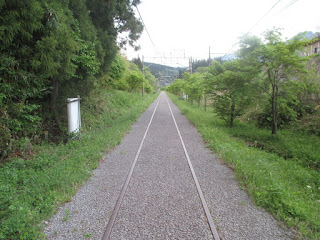My Nakasendo walk continued. Today’s walk started at a place between Annnaka and Matsuida, the 16th shukuba station, passed Matsuida station and arrived at Sakamoto station, which locates at the foot of the Usui Pass and is the last station in Gunma Prefecture.
As
I approached Matsuida, the scenes of the Myogi Mountains became bigger. The
mountains have sharp slopes; the shapes are impressive. I enjoyed seeing the
mountains in the town and over the fields.
Nakasendo
has turned into a shopping street here. Open air markets were held when I visited Matsuida.
I
passed Yokokawa before arriving at Sakamoto. Yokokawa Railway
Station used to be a base station to cross the Usui Pass by the Shinetsu
line. The Abt rack system, one of rack-and-pinion railways, was introduced here
in the late 19th century and survived till 1963. It changed to the Class
EF63 (EF63) electric locomotives and finally finished the operation in 1997
when the bullet train line was open.
Now,
Yokokawa railway station is the last station of Shinetsu line which connects
Takasaki and Yokokawa.
A special run of a steam locomotive train was planned when I visited Yokokawa.
Many locomotive fans were waiting the photo-shot chances along the railway.
Famous “kamameshi” lunch box was developed more than half century ago and became popular for the travelers because the trains stopped there for a while for their locomotive systems’ exchanges and people preferred to eat while waiting. Now kamameshi is popular not only here bat throughout the nation.
A check point of Nakasendo or sekisho was placed near Yokokawa in the Edo era. The gate is preserved.
I met many tourists, including foreign cyclists, at Nakasendo around here. (see the 2nd photo from the top)
A
walkway has been developed along the old rack-and-pinion railways.
The
rail tracks are preserved in some parts.
It
was a big fun for me to walk along the trail.
The
Sakamot shukuba station is about 500 meter high. Nakasendo has now converted
into a well-arranged road. An artificial waterway is developed at the side of
the road.
I found they provided good information of the shukuba,
including that of the main guest house or honjin, here.
Nakasendo
goes into the mountain road to the Usui Pass.

































